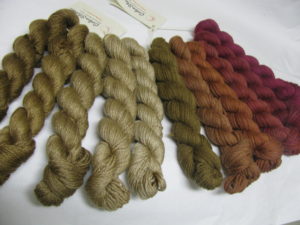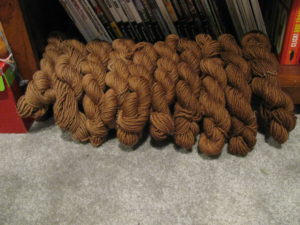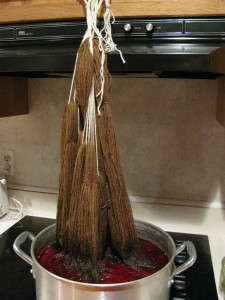The house needs vacuuming, and the web site needs perfecting, but in less than a week begins the Alpaca Festival, so it has taken priority.
http://www.marylandalpacas.org/pages/festival/
This is the 3rd year I have been part of this festival. Year one: giving my first workshop about natural dyeing. Year two: Rebecca, Jared, Leah, and I brought Osborn Fiber Studio. And now year three: Leah and I and 2 friends from MD knitting guilds are bringing ColorStorms. Whew! It’s been a lot of fun and work. Getting my sales and use tax number was the easiest part. Then there was registering the ColorStorms name, getting a bank account, and acquiring my trader’s license. Those last 2 items took several trips to boring grey rectangular offices whose only adornment was Ravens and Orioles banners. Surprisingly, most people behind the counters were not bleak and unfriendly, but rather informative and helpful.

In the mean time, I have been dyeing yarn for 3 straight months. How exciting it was when the pokeberries ripened and the black walnuts fell to the ground. This begins in August and by September is happening in earnest. Dyeing with black walnuts is the easiest of natural dyes. You need only know that the greener the husk, the more dye is preserved. After collecting a bucket full, I dump them into a dye pot and fill it with water to soak overnight. Then in the morning I simmer the husks for an hour. The water turns a chocolatey brown, and this is your dye! It smells wonderful when simmering…..earthy and fresh.
After the dye cools, I drain it into a bucket, dump the walnuts, then pour the dye through a sieve back into a pot. Now it’s ready to dye yarn into any brown hue you like! The more nuts were in your pot, the darker the color. Through experience, I’ve learned to somewhat control the hue and get the lovely gradients shown in the picture. It’s amazing too that if you mordant the yarn in vinegar first, you can add pokeberry juice to color the brown! This is how I achieved the various red-brown shades.
In this pictures I am dyeing various lengths of brown hanks into a pokeberry dye pot.
At the festival I’ll have several brown gradient yarns as well as 100g hanks of Black Walnut Brown and Lucious Latte, both in solid and semi-solid versions. I hope to see you there!


